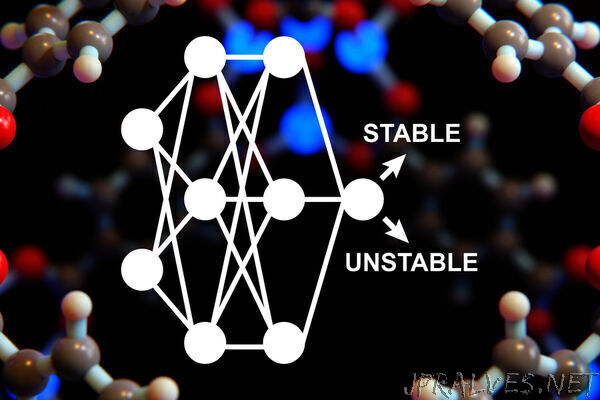
“Chemical engineers use neural networks to discover the properties of metal-organic frameworks, for catalysis and other applications.
Metal-organic frameworks, a class of materials with porous molecular structures, have a variety of possible applications, such as capturing harmful gases and catalyzing chemical reactions. Made of metal atoms linked by organic molecules, they can be configured in hundreds of thousands of different ways.
To help researchers sift through all of the possible metal-organic framework (MOF) structures and help identify the ones that would be most practical for a particular application, a team of MIT computational chemists has developed a model that can analyze the features of a MOF structure and predict if it will be stable enough to be useful.
The researchers hope that these computational predictions will help cut the development time of new MOFs.
“This will allow researchers to test the promise of specific materials before they go through the trouble of synthesizing them,” says Heather Kulik, an associate professor of chemical engineering at MIT.
The MIT team is now working to develop MOFs that could be used to capture methane gas and convert it to useful compounds such as fuels.
The researchers described their new model in two papers, one in the Journal of the American Chemical Society and one in Scientific Data. Graduate students Aditya Nandy and Gianmarco Terrones are the lead authors of the Scientific Data paper, and Nandy is also the lead author of the JACS paper. Kulik is the senior author of both papers.
Modeling structure
MOFs consist of metal atoms joined by organic molecules called linkers to create a rigid, cage-like structure. The materials also have many pores, which makes them useful for catalyzing reactions involving gases but can also make them less structurally stable.
“The limitation in seeing MOFs realized at industrial scale is that although we can control their properties by controlling where each atom is in the structure, they’re not necessarily that stable, as far as materials go,” Kulik says. “They’re very porous and they can degrade under realistic conditions that we need for catalysis.”
Scientists have been working on designing MOFs for more than 20 years, and thousands of possible structures have been published. A centralized repository contains about 10,000 of these structures but is not linked to any of the published findings on the properties of those structures.
Kulik, who specializes in using computational modeling to discover structure-property relationships of materials, wanted to take a more systematic approach to analyzing and classifying the properties of MOFs.
“When people make these now, it’s mostly trial and error. The MOF dataset is really promising because there are so many people excited about MOFs, so there’s so much to learn from what everyone’s been working on, but at the same time, it’s very noisy and it’s not systematic the way it’s reported,” she says.
Kulik and her colleagues set out to analyze published reports of MOF structures and properties using a natural-language-processing algorithm. Using this algorithm, they scoured nearly 4,000 published papers, extracting information on the temperature at which a given MOF would break down. They also pulled out data on whether particular MOFs can withstand the conditions needed to remove solvents used to synthesize them and make sure they become porous.
Once the researchers had this information, they used it to train two neural networks to predict MOFs’ thermal stability and stability during solvent removal, based on the molecules’ structure.
“Before you start working with a material and thinking about scaling it up for different applications, you want to know will it hold up, or is it going to degrade in the conditions I would want to use it in?” Kulik says. “Our goal was to get better at predicting what makes a stable MOF.”
Better stability
Using the model, the researchers were able to identify certain features that influence stability. In general, simpler linkers with fewer chemical groups attached to them are more stable. Pore size is also important: Before the researchers did their analysis, it had been thought that MOFs with larger pores might be too unstable. However, the MIT team found that large-pore MOFs can be stable if other aspects of their structure counteract the large pore size.
“Since MOFs have so many things that can vary at the same time, such as the metal, the linkers, the connectivity, and the pore size, it is difficult to nail down what governs stability across different families of MOFs,” Nandy says. “Our models enable researchers to make predictions on existing or new materials, many of which have yet to be made.”
The researchers have made their data and models available online. Scientists interested in using the models can get recommendations for strategies to make an existing MOF more stable, and they can also add their own data and feedback on the predictions of the models.
The MIT team is now using the model to try to identify MOFs that could be used to catalyze the conversion of methane gas to methanol, which could be used as fuel. Kulik also plans to use the model to create a new dataset of hypothetical MOFs that haven’t been built before but are predicted to have high stability. Researchers could then screen this dataset for a variety of properties.
“People are interested in MOFs for things like quantum sensing and quantum computing, all sorts of different applications where you need metals distributed in this atomically precise way,” Kulik says.
The research was funded by DARPA, the U.S. Office of Naval Research, the U.S. Department of Energy, a National Science Foundation Graduate Research Fellowship, a Career Award at the Scientific Interface from the Burroughs Wellcome Fund, and an AAAS Marion Milligan Mason Award.”
